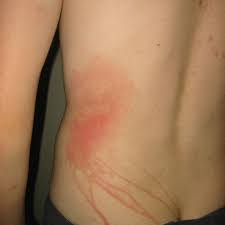Jellyfish stings are accidental – from swimming or wading into a jellyfish or carelessly handling them.
Some types of jellyfish have reproductive jelly gatherings eight to 10 days after a full moon, thus there is an increase in the number of jellyfish found at that time.
Symptoms:
Common signs and symptoms of jellyfish stings include:
- Burning, prickling, stinging pain
- Red, brown or purplish tracks on the skin — a “print” of the tentacles’ contact with your skin
- Itching
- Swelling
- Throbbing pain that radiates up a leg or an arm
Severe jellyfish stings can affect multiple body systems. These reactions may appear rapidly or several hours after the stings. Signs and symptoms of severe jellyfish stings include:
- Stomach pain, nausea and vomiting
- Headache
- Muscle pain or spasms
- Weakness, drowsiness, fainting and confusion
- Difficulty breathing
- Heart problems
The severity of your reaction depends on:
- The type and size of the jellyfish
- Your age, size and health, with severe reactions more likely in children and people in poor health
- How long you were exposed to the stingers
- How much of your skin is affected
The doctor may prescribe:
- diphenhydramine (Benadryl) to help with the itching,
pain medication for pain, and/or
topical steroids or steroids by mouth to help with the swelling and itching.
The doctor may also prescribe antibiotics if the patient has cellulitis. Take all medications as directed and until they are gone.
If it has been longer than 10 years since the patient’s last tetanus shot, a booster shot might be recommended.
🔥29 Views





